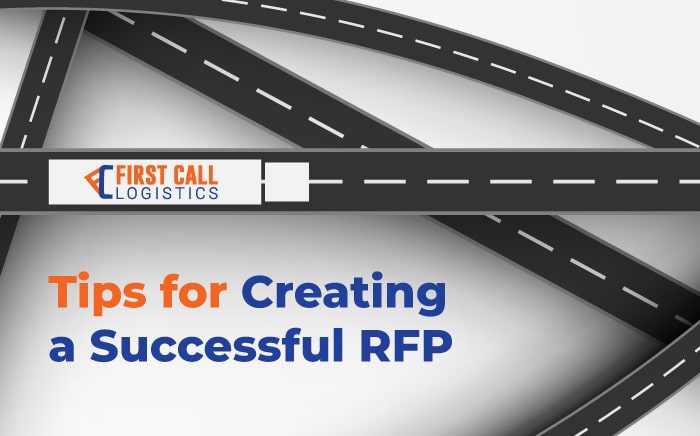Tips for Creating a Successful RFP

A company’s request for proposal process directly impacts the service quality of its potential shipping partners — and by extension, the reliability of its entire supply chain.
Successful RFPs require careful planning to avoid miscommunications and costly disruptions. Clearly outlining the scope of work, budget, specialty equipment (if needed), compliance details and sustainability standards effectively filters out those candidates who aren’t quite cut out for the job at hand.
So, how does one master the art of RFP creation? Let’s explore the basics first.
What is an RFP?
A request for proposal (RFP) is a formal document organizations frequently use to solicit proposals from potential suppliers, vendors, or service providers when seeking to purchase goods or services. The RFP details an organization’s specific expectations and evaluation criteria, which potential partners then use to form proposals or quotes outlining their expertise and the associated costs of completing the tasks listed in the document.
A successful RFP serves as a helpful rubric for evaluating potential partners’ offerings — and their ability to render the services required adequately.
Why Do You Need an RFP?
An RFP is where the strategic relationship between shipper and 3PL provider really begins, as it defines what a successful partnership looks like for each respective party.
From a shipper’s perspective, the RFP simplifies the process of comparing providers and determines the right combination of cost and expertise. Though rates play a significant role in finding the right logistics partner, most shippers understand the lowest rate isn’t always the most valuable offer — 3PLs with proven industry experience, tools to provide accurate freight visibility, 24-hr access to logistics personnel and a strong track record of on-time delivery tend to bring more to the table than less-experienced 3PLs operating strictly on the basis of affordability.
For 3PL providers, an RFP serves as a critical first impression on what might become a long-term business partner, and establishes clear expectations should they be awarded the contract. If an RFP lacks detail or is outdated, the resulting quote will likely prove inaccurate as the scope of service changes.
Thus, an RFP sets shipper-3PL partnerships up for success by aligning expectations on the scope of work and pricing from the start.
Steps to Crafting a Successful RFP
A good RFP is clear and specific. Adding “fluff” will only obscure what your business hopes to gain from a successful partnership — instead, stick to the following steps:
1. Introduce Your Business. Provide a brief but informative introduction to your company, including your industry, business goals and the type of products you ship. This tells potential partners the basic drivers behind your distribution needs.
2. Define the Problem. Clearly articulate specific problems or pain points you want the 3PL provider to address. Include essential parameters like delivery regions, packaging specifications, weight, size and key performance indicators (KPIs). Don’t forget to include the expected contract duration, as this may impact pricing.
3. Stay Updated. Ensure the data in your RFP is accurate and up-to-date. Insufficient shipping information (such as a change in delivery location or special equipment requirements) will almost certainly produce inaccurate quotes. Stay informed about current market trends to provide the most relevant information to potential 3PL candidates.
4. Ask Pertinent Questions. Use the RFP as a means to gather information from potential candidates by exploring the following:
- Do you have experience in our industry?
- What is your available growth capacity?
- Can you provide multiple references?
- What is your typical timeline for projects sharing similar scopes?
- Why is your company the best choice for this project?
5. Provide Response Instructions. Standardize proposals by offering clear instructions for content and formatting. Consider providing a template for 3PL providers to complete with their proposed solutions.
When Is the Best Time to Submit an RFP?
While it’s generally best to submit an RFP as soon as a pressing issue arises, there are a few strategic advantages working in your favor if you can manage to wait for winter. First quarters are typically excellent periods for RFP submissions, as 3PL providers are already in the process of organizing their contracts for the year and shipping rates are typically lower. Conversely, an RFP submitted in the summer will generally attract higher rates due to peak produce season and holiday preparations leading to tighter carrier capacity.
No matter when you submit your RFP, aim to condense the entire process from submission to selection down to about 6-8 weeks — after all, you wouldn’t want to miss out on the perfect 3PL partner because they no longer had room to take on your business.
Learn more about how First Call Logistics’ diverse industry expertise and real-time tracking tech made us the preferred logistics provider for partners nationwide by contacting us today; we look forward to speaking with you!
Simplify your Next Shipment with First Call Logistics
Building and managing cost-efficient supply chains is a full-time job. First Call’s rare combination of in-house assets, expert problem-solving and track record of stellar customer service makes us the 3PL of choice for business partners with a wide range of shipping needs.
More Resources for FCL Shippers:
- Article: The Importance of On-Time In-Full (OTIF) Delivery
- Article: Keeping Up With MABD: What It Is and Best Practices
- Article: Understanding Accessorial Charges
- Article: How Partnering with a 3PL Strengthens Your Supply Chain
- Article: Avoiding Supply Chain Chargebacks
- Article: The Cost of Freight Damage — and How to Prevent It
- Article: Managing Product Rejection: Causes, Resolution and Prevention
Get the latest supply chain news and updates directly to your inbox.
